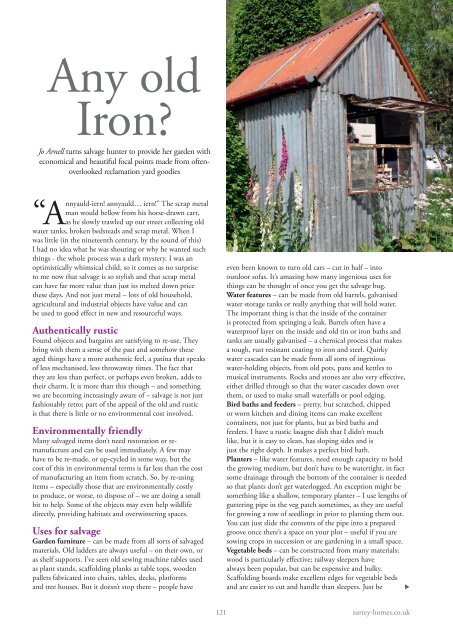Surrey Homes | SH36 | October 2017 | Kitchen & Bathroom supplement inside
The lifestyle magazine for Surrey - Inspirational Interiors, Fabulous Fashion, Delicious Dishes
The lifestyle magazine for Surrey - Inspirational Interiors, Fabulous Fashion, Delicious Dishes
Create successful ePaper yourself
Turn your PDF publications into a flip-book with our unique Google optimized e-Paper software.
Any old<br />
Iron?<br />
Jo Arnell turns salvage hunter to provide her garden with<br />
economical and beautiful focal points made from oftenoverlooked<br />
reclamation yard goodies<br />
annyauld… iern!” The scrap metal<br />
man would bellow from his horse-drawn cart,<br />
“Annyauld-iern!<br />
as he slowly trawled up our street collecting old<br />
water tanks, broken bedsteads and scrap metal. When I<br />
was little (in the nineteenth century, by the sound of this)<br />
I had no idea what he was shouting or why he wanted such<br />
things - the whole process was a dark mystery. I was an<br />
optimistically whimsical child, so it comes as no surprise<br />
to me now that salvage is so stylish and that scrap metal<br />
can have far more value than just its melted down price<br />
these days. And not just metal – lots of old household,<br />
agricultural and industrial objects have value and can<br />
be used to good effect in new and resourceful ways.<br />
Authentically rustic<br />
Found objects and bargains are satisfying to re-use. They<br />
bring with them a sense of the past and somehow these<br />
aged things have a more authentic feel, a patina that speaks<br />
of less mechanised, less throwaway times. The fact that<br />
they are less than perfect, or perhaps even broken, adds to<br />
their charm. It is more than this though – and something<br />
we are becoming increasingly aware of – salvage is not just<br />
fashionably retro; part of the appeal of the old and rustic<br />
is that there is little or no environmental cost involved.<br />
Environmentally friendly<br />
Many salvaged items don’t need restoration or remanufacture<br />
and can be used immediately. A few may<br />
have to be re-made, or up-cycled in some way, but the<br />
cost of this in environmental terms is far less than the cost<br />
of manufacturing an item from scratch. So, by re-using<br />
items – especially those that are environmentally costly<br />
to produce, or worse, to dispose of – we are doing a small<br />
bit to help. Some of the objects may even help wildlife<br />
directly, providing habitats and overwintering spaces.<br />
Uses for salvage<br />
Garden furniture – can be made from all sorts of salvaged<br />
materials. Old ladders are always useful – on their own, or<br />
as shelf supports. I’ve seen old sewing machine tables used<br />
as plant stands, scaffolding planks as table tops, wooden<br />
pallets fabricated into chairs, tables, decks, platforms<br />
and tree houses. But it doesn’t stop there – people have<br />
even been known to turn old cars – cut in half – into<br />
outdoor sofas. It’s amazing how many ingenious uses for<br />
things can be thought of once you get the salvage bug.<br />
Water features – can be made from old barrels, galvanised<br />
water storage tanks or really anything that will hold water.<br />
The important thing is that the <strong>inside</strong> of the container<br />
is protected from springing a leak. Barrels often have a<br />
waterproof layer on the <strong>inside</strong> and old tin or iron baths and<br />
tanks are usually galvanised – a chemical process that makes<br />
a tough, rust resistant coating to iron and steel. Quirky<br />
water cascades can be made from all sorts of ingenious<br />
water-holding objects, from old pots, pans and kettles to<br />
musical instruments. Rocks and stones are also very effective,<br />
either drilled through so that the water cascades down over<br />
them, or used to make small waterfalls or pool edging.<br />
Bird baths and feeders – pretty, but scratched, chipped<br />
or worn kitchen and dining items can make excellent<br />
containers, not just for plants, but as bird baths and<br />
feeders. I have a rustic lasagne dish that I didn’t much<br />
like, but it is easy to clean, has sloping sides and is<br />
just the right depth. It makes a perfect bird bath.<br />
Planters – like water features, need enough capacity to hold<br />
the growing medium, but don’t have to be watertight, in fact<br />
some drainage through the bottom of the container is needed<br />
so that plants don’t get waterlogged. An exception might be<br />
something like a shallow, temporary planter – I use lengths of<br />
guttering pipe in the veg patch sometimes, as they are useful<br />
for growing a row of seedlings in prior to planting them out.<br />
You can just slide the contents of the pipe into a prepared<br />
groove once there’s a space on your plot – useful if you are<br />
sowing crops in succession or are gardening in a small space.<br />
Vegetable beds – can be constructed from many materials;<br />
wood is particularly effective; railway sleepers have<br />
always been popular, but can be expensive and bulky.<br />
Scaffolding boards make excellent edges for vegetable beds<br />
and are easier to cut and handle than sleepers. Just be <br />
121 surrey-homes.co.uk


















